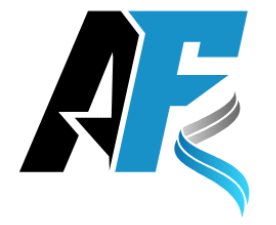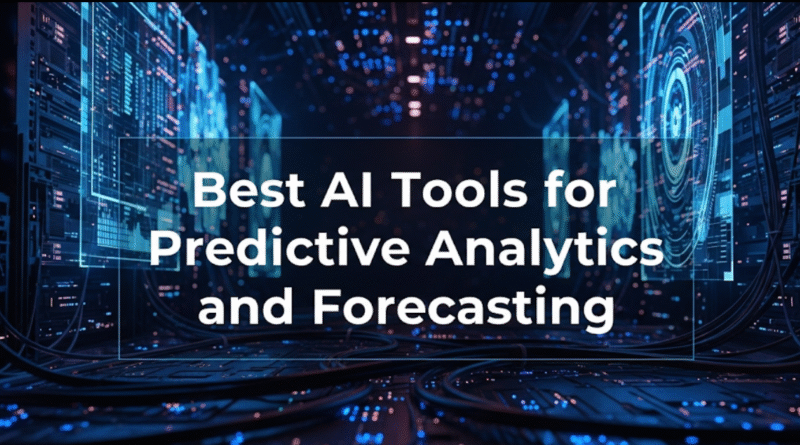Best AI Tools for Predictive Analytics and Forecasting
In the constantly evolving world of business, being able to make good decisions based on the future is what often keeps companies afloat. Predictive analytics and forecasting are key for any company that wishes to outshine and outlive its competition. The only question is: With so many AI-powered software available on the market, how can one choose the right one? This guide takes a look at the most promising solutions that assist you in predicting revenue trends and staying agile when planning your company’s future. No matter if you’re a small business owner or a high-ranking executive at a huge corporation, you’ll find something that will revolutionize your planning methods.
Why AI is the Perfect Solution for Predictive Analytics
So why did artificial intelligence change the way we approach predictive analytics? Until not so long ago, most forecasting simply relied on what occurred in the past, usually in the form of basic statistical models. Nowadays, however, AI can process enormous quantities of data and reveal quite complex correlations in real time.
AI is ideal for predictive analytics because it has the capability to:
- Track thousands of data points in the same observation
- Always learn from fresh information
- Detect trends hidden from humans
- Change to market fluctuations at a moment’s notice
- Give you a forecast that demonstrates measurable accuracy
Examples of High-End AI Platforms That Enable Enterprise Forecasting
IBM Watson Analytics
IBM Watson Analytics is one of the most powerful solutions that are available for enterprise-driven predictive modeling. Due to natural language processing capabilities provided by machine learning algorithms, it would be more convenient for lay users to use.
Key features:
- Automatic preparation and scrubbing of data
- State-of-the-art statistically-based modeling
- Interactive visualization and dashboard facilities
- Integration with various data sources
- Update forecasts in real time
Suitable for: Large organizations with complex data demands, as well as significant analytics budgets
Pricing: Bespoke pricing levels based on usage and attributes
Microsoft Azure Machine Learning
Microsoft’s cloud-based platform delivers powerful predictive analytics, using a drag-and-drop interface. It is an easy way to build, train, and deploy machine learning models for those who have limited coding experience. Pre-built algorithms and automated capabilities make this tool readily accessible to even novices.
Pricing: Azure ML works on a pay-as-you-go model, starting from $0.20 per compute hour.
Ideal for: Companies already using Microsoft products and requiring cloud solutions for their growth.
Google Cloud AI Platform
Leveraging the same technology that powers Google’s search and recommendation systems, Google Cloud AI Platform is the perfect solution for creating and training advanced forecasting models. We recommend Google Cloud AI Platform for companies that are accustomed to working with advanced technology and prefer full integration with the cloud ecosystem.
Salesforce Einstein Analytics
Salesforce Einstein is tailored to the customer relationship management sector due to excellent sales predicting.
Ideal For: Salesforce Ecosystem and Sales & Customer Service Teams
Cost: $150 per user per month on top of Salesforce licenses
DataRobot Automated Machine Learning
What DataRobot does well (this is not a free tool, by the way) is automate the entire machine-learning process — democratizing predictive analytics! Upload your data and receive accurate forecasting models within hours.
Key Features:
- Automated feature engineering
- Model selection and optimization
- Bias detection and fairness testing
- Model deployment and monitoring
- Collaborative model development
Ideal For: Good fit for mid-size companies that want accurate predictions but don’t have data science skill sets
Pricing: Custom pricing depending on volume of data and features needed.
Specialized Tools for Specific Industries
Financial Forecasting Solutions
Palantir Gotham
Palantir Gotham began as a government intelligence tool and is now used by financial services to perform advanced risk modeling and fraud detection.
Unique Features:
- Real-time transaction monitoring
- Complex relationship mapping
- Regulatory compliance tracking
- Custom algorithm development
Kensho Technologies
Kensho — Predictions of the US financial markets are made based on machine learning and NLP (Acquired by S&P Global).
Unique Features:
- Market event impact analysis
- Economic indicator correlation
- Investment portfolio optimization
- News sentiment analysis integration
Retail and E-commerce Forecasting
Dynamic Yield
With this personalization platform, you can use AI to forecast customer behavior and adjust marketing campaigns in real-time.
Key Features:
- Customer lifetime value prediction
- Product recommendation engines
- Price optimization algorithms
- Inventory demand forecasting
Blue Yonder (formerly JDA Software)
Designed to optimize supply chain, retail facing forecasting in various industries.
Key Features:
- Demand sensing technology
- Inventory optimization
- Price and promotion planning
- Supply chain risk assessment
Healthcare Predictive Analytics
IBM Watson Health
Zooms in on healthcare applications, ranging from predicting patient outcomes to drug discovery.
Key Features:
- Clinical decision support
- Population health management
- Medical imaging analysis
- Drug interaction predictions
Optum AI
For example, UnitedHealth Group offers an AI platform that excels in predicting healthcare costs and patient risk tendencies.
Key Features:
- Claims processing automation
- Provider network optimization
- Patient outcome modeling
- Care gap identification
Open-Source and Budget-Friendly Options
Python-Based Solutions
There are a number of highly sophisticated open-source libraries out there that offer enterprise-level forecasting capabilities for organizations with technical teams:
Scikit-learn
- Comprehensive machine learning library
- Excellent documentation and community support
- A variety of algorithms for each type of prediction task
- Free to use and modify
Prophet (by Facebook)
- Built especially for time series forecasting
- Automatically handles missing data & outliers
- Great with seasonal data patterns
- Minimal parameter tuning required
TensorFlow and Keras
- Advanced Uses — Deep Learning for complex predictions
- Neural Networks and Advanced Algorithms supported
- A wide range of tools and extensions
- Strong community and Google backing
R Programming Environment
The popularity of R amongst statisticians and data scientists in modeling capabilities with its statistical:
Forecast Package
- Comprehensive time series analysis
- Automatic model selection
- Advanced statistical methods
- Publication-ready visualizations
Caret Package
- Classification and regression training
- Model comparison and validation
- Feature selection automation
- Parallel processing support
Top AI Forecasting Tools: Feature Comparison Table
| Tool | Type | Ideal For | Pricing | Ease of Use | Key Strength |
|---|---|---|---|---|---|
| IBM Watson Analytics | Enterprise | Enterprise companies | Custom | Medium | Advanced AI capabilities |
| Microsoft Azure ML | Cloud | Users of other MS products | Pay-per-use | High | Cloud integration |
| Google Cloud AI | Cloud | Tech teams | Usage-based | Medium | Scalability |
| Tableau | Business | Business users | $70+/month | High | Visualization |
| Salesforce Einstein | CRM | Sales teams | $150/month | High | CRM integration |
| DataRobot | Automated | Mid-size companies | Custom | High | Automation |
| Python libraries | Open-source | Developers | Free | Low | Flexibility |
| R packages | Statistical | Statisticians | Free | Low | Statistical depth |
Features to Look for in AI Forecasting Tools
Below are some of the fundamental characteristics to be considered when choosing a predictive analytics solution.
Data Integration Capabilities
- Multiple Data Source Support — Databases, APIs, Files
- Real-time data streaming options
- Data cleaning and preparation tools
- Cloud storage integration
Model Performance and Accuracy
- Cross-validation testing methods
- Accuracy metrics and confidence intervals
- Model comparison capabilities
- Automatic model retraining options
User Interface and Accessibility
- Intuitive dashboard design
- Drag-and-drop functionality
- Mobile device compatibility
- Role-based access controls
Scalability and Performance
- Ability to handle large datasets
- Fast processing and prediction speeds
- Multi-user collaboration features
- API integration options
Support and Documentation
- Comprehensive user guides and tutorials
- Active community forums
- Professional support services
- Regular software updates

Best Practices for Highest Success upon Implementation
Start with Clean, Quality Data
Prediction precision relies greatly on the quality of data. So before using any AI tool, make sure your data is:
- Complete and up-to-date
- Properly formatted and structured
- Free from errors and inconsistencies
- Representative of your business context
Choose the Right Metrics
Other success metrics are needed for different forecasting scenarios:
- Sales Data: Mean Absolute Percentage Error (MAPE)
- Inventory Planning: Mean Absolute Deviation (MAD)
- Financial Forecasting: RMSE (Root Mean Square Error)
- Customer Behavior: Precision and recall rates
Plan for Change Management
Successful implementation requires organizational buy-in:
- Teach new tools and preparation of processes to teammates
- Set clear boundaries on when to use predictions
- Design feedback channels for iterative improvements
- Write lessons learned and best practices
Monitor and Adjust Regularly
Predictive models require ongoing maintenance:
- Track prediction accuracy over time
- Continuously retrain models on new data
- Adjust parameters based on performance
- Update with new features and capabilities
7 Problematic Scenarios and Their Solutions
Data Silos and Integration Issues
Data sprawl costs many organizations dearly. Solutions include:
- Implementing data warehousing solutions
- ETL (Extract, Transform, Load) Tools
- Creating standardized data formats
- Establishing data governance policies
Lack of Technical Expertise
Not all organizations have a data scientist on their payroll. Address this by:
- Choosing user-friendly, automated tools
- Investing in training and education
- Partnering with consulting firms
- Proceeding from simpler use cases to advanced ones
Resistance to Change
Old habits die hard and we know change is not accepted easily especially when it comes to bringing in newer technologies in the team. Overcome this through:
- Demonstrating clear business value
- Providing comprehensive training programs
- Starting with pilot projects
- Celebrating early wins and successes
Future Trends in AI-Powered Forecasting
Automated Machine Learning (AutoML)
AutoML platforms are opening up the world of predictive analytics to non-technical users by taking care of model selection, training and optimization.
Edge Computing Integration
Bringing predictive assets nearer to the data sources decreases latency and enables stronger real-time decision-making powers.
Explainable AI
The new tools support the increased transparency and interpretability of AI predictions, bolstering trust in these automated forecasting systems.
Quantum Computing Applications
Quantum computing, although still in its infancy, has the potential to offer a faster solution for complex optimization problems over regular computers.
Frequently Asked Questions
Predictive analytics vs forecasting
Predictive analytics is a general term for any modern data analysis approach designed to predict some aspect of the future. In this blog post, I would speak about forecasting… Forecasting is simply predicting the future values of time-based data; for example sales trends or stock prices! You could say that anything is predictive analytics, but not all predictive analytics is like forecasting.
Are AI forecasting tools pretty accurate?
The accuracy varies from model to model on how clean the data is, how complex the model is and what the use case was for this analysis. Given that forecasting tools using AI are properly implemented, they can get 80% up to 95% accurate for short-term predictions depending on the quality of the dataset as it gets less accurate at long-run forecast. Correctly using the right tool in your area of focus depending on what you want to achieve and also trying as much as possible to ensure that you have high-quality data.
Does this need a data scientist to handle these tools?
Quite a few AI forecasting tools are created for business users (not techies!) so they should handle more subtle nuances. Ease of use: Tools such as Tableau, Salesforce Einstein, and DataRobot have been purposely designed with the non-techie professional in mind so that they may be used without needing much technical background. Nevertheless, when you have an analytical person, that can improve the efficiency of results and the presentation of information.
What Does Implementing AI Forecast Tools Cost?
You can have a range of costs depending on your number of users and the amount of data that you will be indexing. These budget-friendly options will cost $50-100 per user per month, compared to enterprise solutions that can set you back several thousand dollars monthly. The open source solutions similar to wordpress is free to use but requires technical knowledge or time.
How quickly can a company start seeing the results of using AI forecasting tools?
Basic forecasting models — can deliver initial results within days or a week from implementation. Gladly, the most accurate results usually come from 2 to 6 months of data collection and tweaking of your model. The timeline is ultimately determined by data availability, model complexity and organizational readiness.
Are the AI forecasting tools effective on small datasets?
As a rule of thumb, AI tools do better the more data they have, but many of today’s platforms can still handle relatively small datasets perfectly fine. Some tools are designed for small businesses with low data volumes. The trick is to select a tool which fits in your data size and complexity.
What kind of data is suitable for AI forecasting tools?
As AI forecasting models essentially derive insight from data, they work great with structured numerical time-sensitive data; i.e., the kind of information that follows clear patterns over time. Such examples range from sales figures, and site traffic, to the stock level and consumer behavior metrics. Other sophisticated platforms even can deal with unstructured data including texts and images as well.
What about data privacy and security with cloud-based AI tools?
Opt for providers that are SOC 2/ISO 27001 Certified. Carefully review data handling policies, know where your data is stored and being processed, deploy encryption for your sensitive data, opt for on-premise solutions when it comes to high-risk scenarios.
Choosing the Best for Your Organization
Choosing the Right AI Tool for Predictive Analytics: The solution of predictive analytics is relevant to having the right type of advanced tools which can answer most unique questions. Think about how advanced of a user you are, your budget (if any), how complicated your data is and what type of business requirements you have.
User-friendly systems are ideal starting points for small businesses that have never used predictive analytics before — such as those provided by Tableau or Salesforce Einstein. Small and mid-size companies may prefer an automated solution like DataRobot, or opt for cloud-based platforms from Microsoft & Google as their data volume increases.
For example, you may need to use IBM Watson Analytics (a comprehensive solution), or even invest in the development of your own machine learning software built on open-source tools.
Keep in mind that predictive analytics can bring success not only by choosing the tool but also how you implement this data, control the quality of your data and what type of level has those who get influenced by it. Take it slow, test and learn, then progress toward predictive analytics as your team gains confidence in using the technologies.
Tomorrow belongs to those companies that can best anticipate, adapt and deliver what customers will want before customers themselves even know. With the proper AI forecasting tools used correctly, your ability to make more informed business decisions, mitigate risk and capitalize on high impact developments across your market has never been higher.

